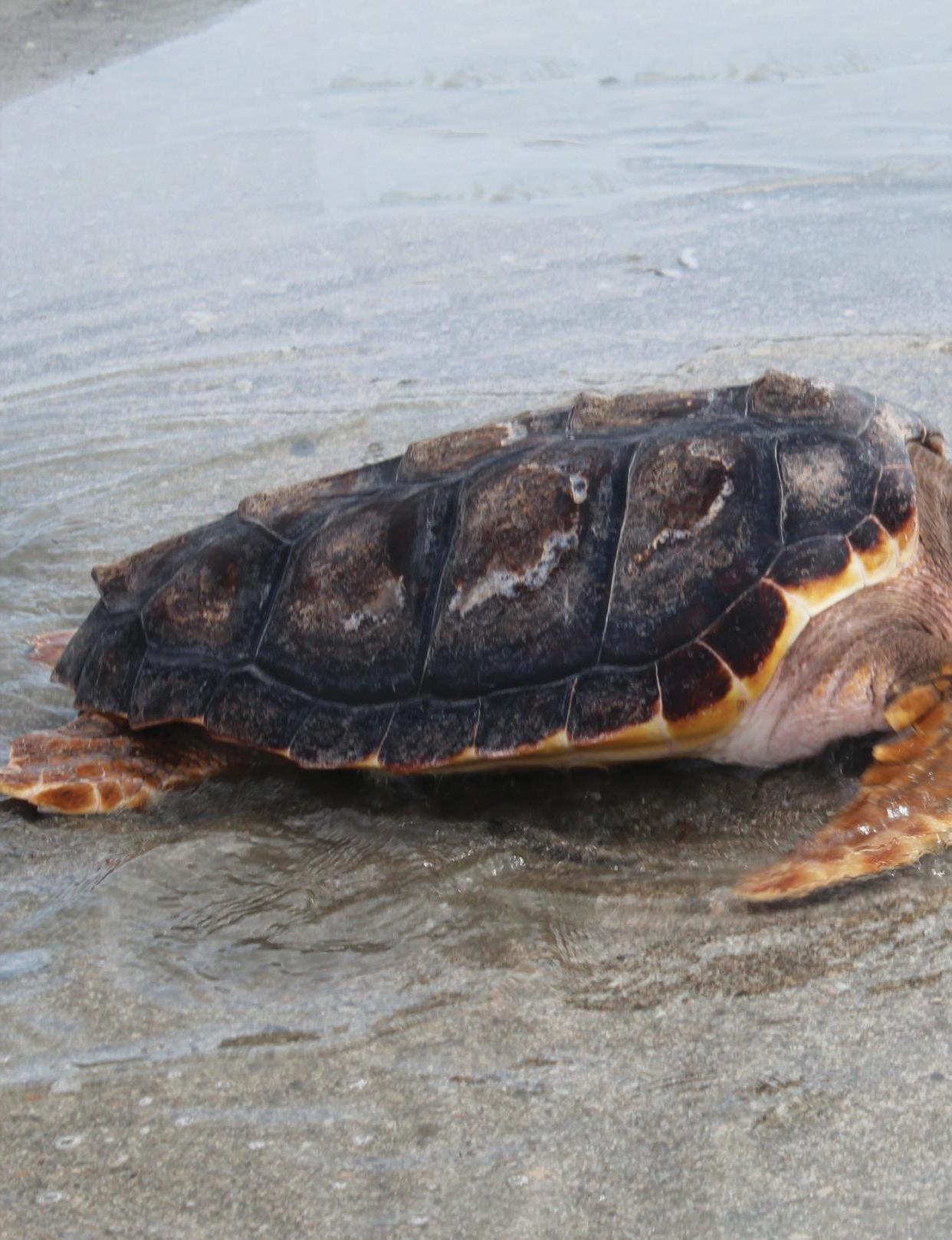
7 minute read
Releasing Neptune
On a beautiful summer morning this August, two days after her third birthday, a loggerhead sea turtle named Neptune swam into the waters of Wassaw Sound for the first time in her young life. Southern Tides Magazine was lucky to be there to witness her release and learn about the role Neptune played in sea turtle conservation and expanding our knowledge of these magnificent creatures.
In the summer of 2018, the UGA Aquarium on Skidaway Island, part of UGA Marine Extension and Georgia Sea Grant, had a vacancy for a sea turtle hatchling. The team reached out to Mark Dodd, who heads the GADNR Sea Turtle Conservation Program and coordinates the Georgia Sea Turtle Cooperative, and when a straggler was found in a nest that hatched on Ossabaw Island on August 8, arrangements were made for the tiny survivor to be taken to the aquarium. Stragglers that don’t leave the nest have zero chance of survival.
Advertisement
Because the nest temperatures were monitored as part of DNR research, the team knew the young turtle was female. Nest temperatures determine the sex of the hatchlings with higher temperatures resulting in female turtles while lower temperatures result in males. And because she was born on the eighth day of the eighth month, she was given the name Neptune, eighth planet and God of the sea.
So what was her early life in the aquarium like?
“It’s amazing to me that sea turtles already know how to swim immediately after hatching, but in those early days, Neptune still had to practice and master things like balance, coordination, turning and buoyancy control. She also had to learn how to utilize her tank environment to rest and sleep when needed,” said Devin Dumont, aquarium curator.
Her diet in the early days consisted of several meals a day, made up of minced pieces of shrimp or fish, frozen seafood slurry, and a nutritional supplement called gel food. As she grew her daily meals grew as well, for proper growth and development.
While she grew, Neptune captivated aquarium visitors and was


Above: Devin Dumont holds Neptune while Joe Pfaller applies a tag to her flipper. Right: Posing for photos. The sign reads, "August 10, 2021, 3 years and 2 days old! IT'S RELEASE DAY!!! Goodbye Neptune."
featured in many formal education programs. In this role she was an education ambassador for loggerheads and played an active part in raising awareness about loggerheads and sea turtle conservation on our Georgia coast. Aquarium staff, students from Savannah State University and Georgia Southern University participated in a collaborative study to use behavior analysis methods in efforts to improve enrichment practices.
“Oftentimes with organisms in managed care facilities, animals tend to engage in non-species-specific behaviors that aren’t adaptive in their natural environments,” said Andrew Bulla, Ph.D., professor of psychology and faculty mentor to GSU students. “With environmental enrichment, the captive environment in which the turtles live mimics their natural habitat, which increases their chances for survival once released. It also provides valuable data for researchers and hands-on experiences for students in the psychology field.”
In the months prior to her release, Neptune’s diet played a role in these enrichment activities. Live food was introduced, to include blue crabs, mussels and other shellfish that make up loggerhead diets in the wild, which allowed her to hone or foraging and hunting skills and in turn increase her chances of survival after her release. On her release date, she weighed in at almost 45 pounds and her carapace measured 22 inches.

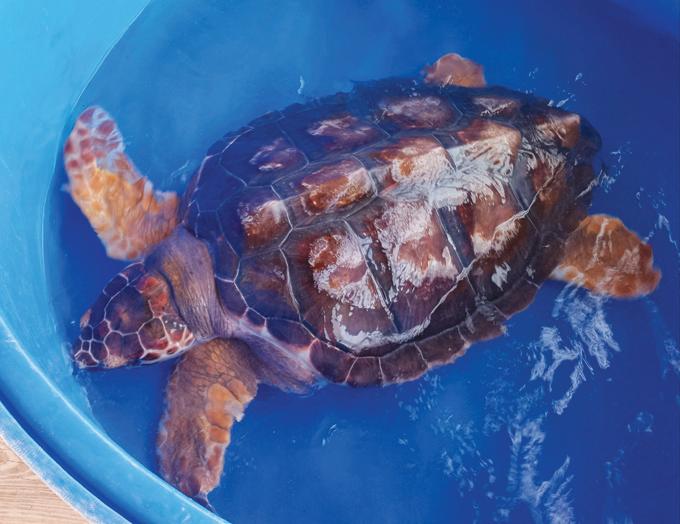

Above left: Neptune in the tank used to transport her to the release site. Above right: Tag placed on the bottom edge of her left flipper. This image: Devin Dumont and Lisa Kovalanchik carrying Neptune to her release site on Wassaw Island's north beach.
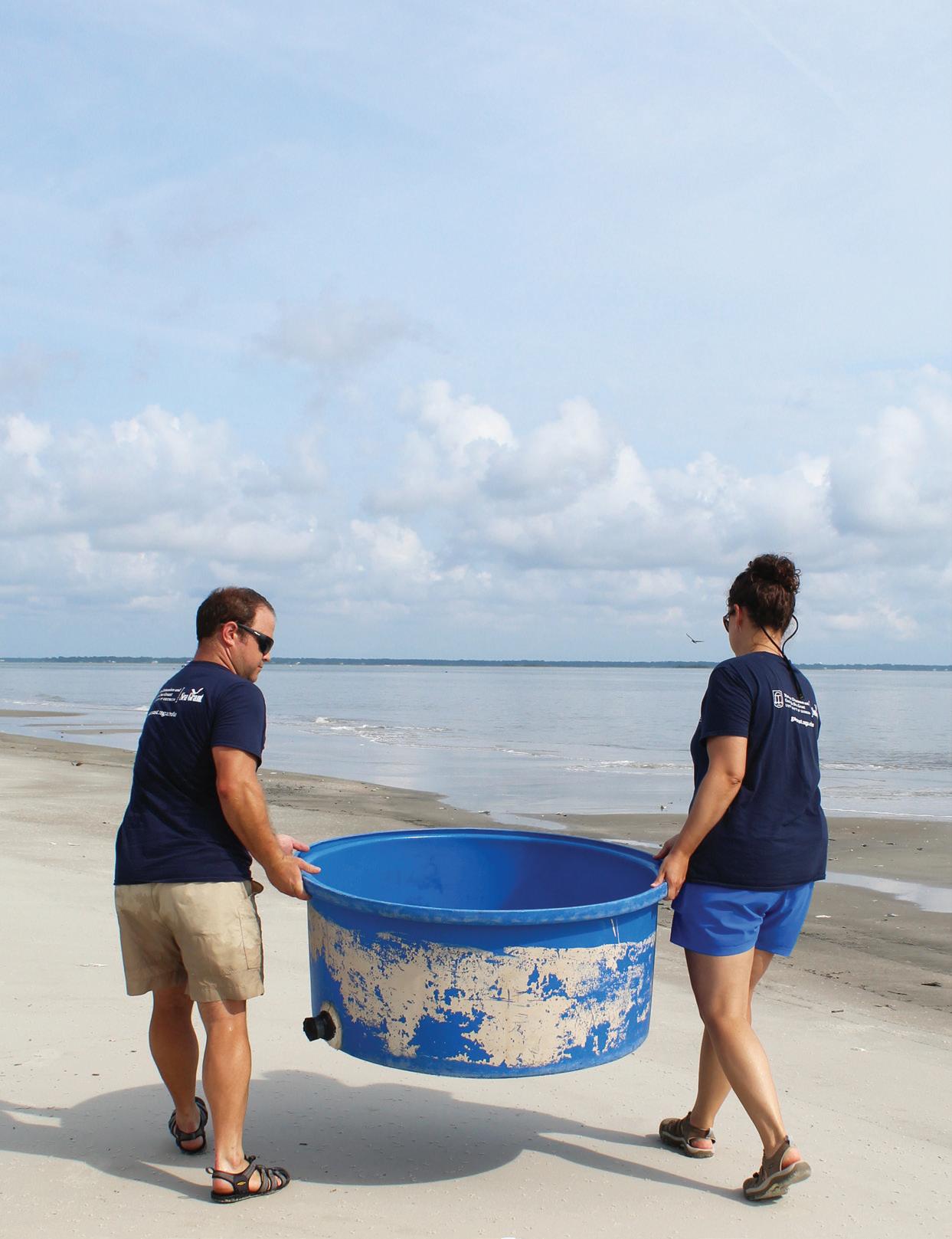

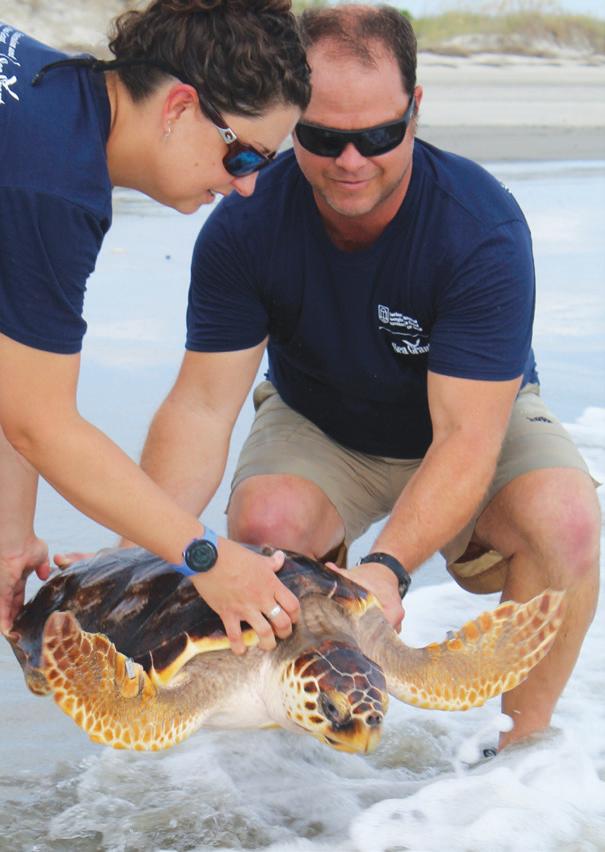
The morning of her release, Neptune was tagged, providing us with one more opportunity to learn from her. A small inobtrusive and painless PIT tag, or passive integrated transponder, was implanted under her skin by Joe Pfaller, Ph.D., with the Caretta Research Project, in Savannah, and Archie Carr Center for Sea Turtle Research, in Gainesville, Fla. The tag should still read in 20 or more years if she comes back to either Wassaw or Jekyll Islands, both of which have nighttime tagging patrols.
“Tagging sea turtles has helped reveal may mysteries in sea turtle biology, mostly in terms of where they go and how long they live. By giving Neptune individualized tags, we will be able to identify her if she is encountered later in life, maybe even at a nesting beach!” Pfaller said.
All sea turtle tags have an address on the back, and deployments are catalogued in a central database at the University of Florida.
“If Neptune is seen again there will be a coordinated effort to inform us of her sighting, which helps us learn about and better protect the species,” Pfaller added.
What might Neptune’s life be like after her release?
No one is really certain. Dumont and Pfaller agree that her instincts should kick in as she learns her environment. With luck she remains nearshore for now, feeding on the bottom for crabs, mussels and other shellfish – and avoiding boats and predators. As water temperatures change with the seasons she’ll likely begin moving offshore and inshore accordingly. We all hope she returns to a Georgia beach to nest one day!
Above: Lisa and Devin help Neptune get closer to the surf as she waves her flippers, seemingly eager for her first foray into the ocean.
Opposite page: Close-up image of Neptune.
Sea Turtle Information UGA Marine Extension and Georgia Sea Grant: gacoast.uga.edu/ Sea Turtle Nest Data: www.seaturtle.org/nestdb/ Caretta Research Project: www.carettaresearchproject.org/ Georgia Sea Turtle Cooperative: georgiawildlife.com/seaturtlecooperative.
Adventure Log: August 10, 2021 Neptune's Release
It was a lovely August morning when I arrived at the UGA Skidaway campus docks and I was glad the weather cooperated on such a special day. Getting to ride along and see a sea turtle released isn’t something you get many opportunities to be part of and I was thrilled to be included.
Once everyone had arrived, Lisa Kovalanchik and Devin Dumont assisted Joe Pfaller as he applied Neptune’s tags, then photos were taken.
It was amazing to be that close to a sea turtle! Her big eyes, the colors of her head, beak and shell, those big flippers, she was just stunning and I could have sat next to her all day, just looking at her!
After the photo opportunities, she was placed in a large blue tub for the boat ride, then we all enjoyed a lovely trip out to Wassaw Island. Dolphins were active as we motored up the Skidaway River then rounded the bend into the Wilmington River. It felt good to be back on that stretch of water where I’ve spent so much time.
Too soon, we arrived in Wassaw Sound and anchored off the north beach of Wassaw Island. Neptune’s tub was carried ashore as we all waded up to the beach and gathered to watch her first steps toward freedom.
Devin and Lisa lifted Neptune out of the tub and set her on the sand where small waves were rolling in, within her reach. She seemed curious and maybe a little uncertain as she stretched her flippers and moved around a bit. She headed toward the water at an angle, at one point heading straight towards me – for which I’m grateful as she gave me the perfect shot for the cover photo! After snapping the picture I moved out of her line of sight to avoid being a distraction and give her a clear path to the water. She still needed a little assistance though, so Devin and Lisa picked her up again and took her a little closer to the waves. As they lifted her, she moved her flippers back and forth, much in the way some dogs will paddle if held over water.
After one final assist from Devin and Lisa, she dove into the waves and disappeared from view. We all stood watching and saw her head break the surface a couple hundred yards off the beach.
Sea turtles are solitary creatures, typically coming together only to mate, and otherwise exploring and foraging alone. I could imagine her out there, swimming in any direction she chose, taking in her surroundings, seeing other sea life swimming by, at last able to follow her instincts and the rhythms of the sea.
Neptune was free.
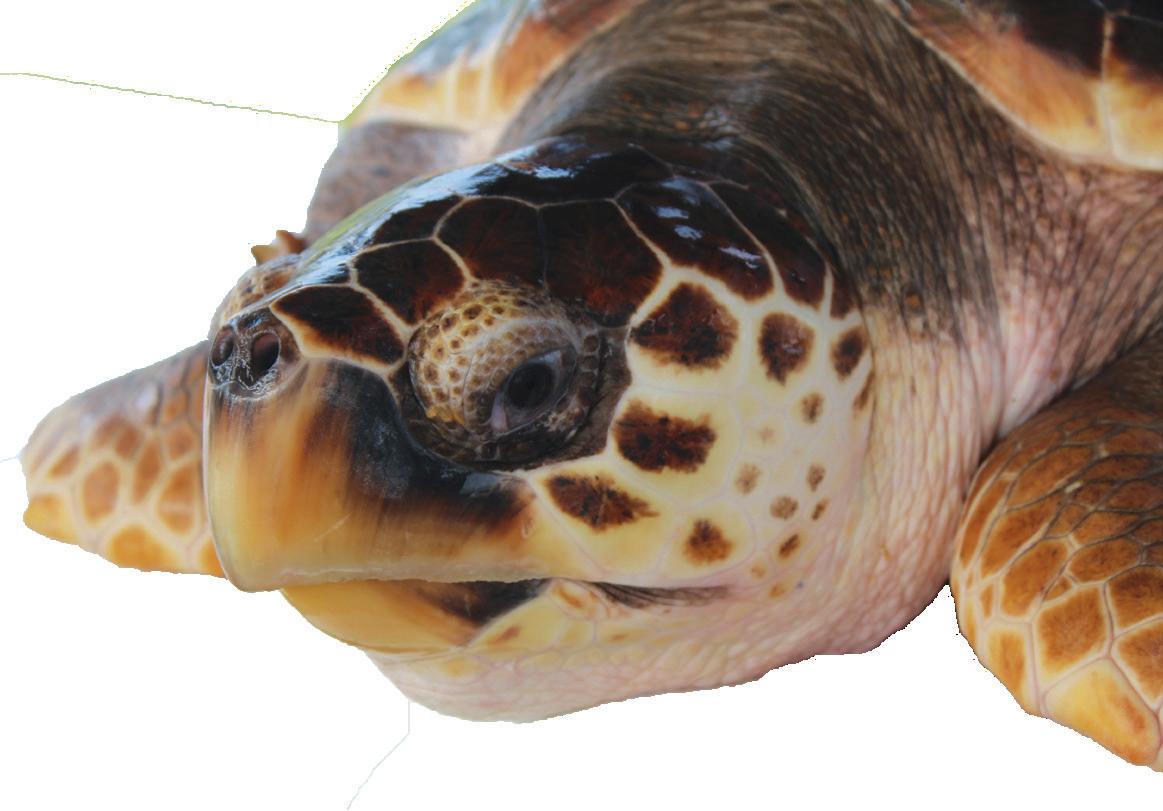
Sincere thanks to Emily Kenworthy, Devin Dumont, Lisa Kovalanchik, Todd Recicar, Dodie Sanders, and the rest of the team at UGA Marine Extension and Georgia Sea Grant, and to Joe Pfaller with Caretta Research Project and Drew Bulla with Georgia Southern University. It was a phenomenal experience! Thank you for including Southern Tides Magazine!








